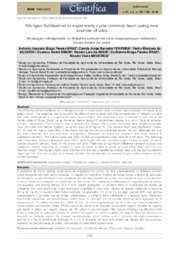Nitrogen fertilization in super-early cycle common bean using new sources of urea.
Nitrogen fertilization in super-early cycle common bean using new sources of urea.
Author(s): BRAZ, A. J. B. P.; FERREIRA, C. J. B.; SILVEIRA, P. M. da; SIMON, G. A.; ASSIS, R. L. de; BRAZ, G. B. P.; MEDEIROS, R. V.
Summary: The efficiency of new fertilizers as a nitrogen source in super-early cycle common bean cultivars still needs to be better known. The objective was to quantify the effect of new sources and time of application of nitrogen on yield and yield components of a super-early cycle bean cultivar. The experiment was conducted in the city of Rio Verde, state of Goias, Brazil, using the experimental design of randomized blocks, in a 3x3+1 factorial scheme, with four replications. The first factor was constituted by nitrogen (N) sources: traditional urea, zeolite-associated urea, and urea with urease inhibitor, using the dose of 80 kg ha-1 N. The second factor was application stages: V2, V3, and V4, that is, when 50% of the plants had the first pair of unifoliolate leaves, the first trifoliolate leaf, and the third trifoliolate leaf fully expanded, respectively. Moreover, an additional treatment was used, without N application (control). The cultivar used was BRS FC104, of super-early cycle, from 60 to 65 days. The following were measured: relative chlorophyll index (RCI), plant height, first pod insertion height, number of pods per plant, number of grains per pod, mass of 100 grains and yield. There was no significant difference between sources and application stages regarding the number of pods per plant, number of grains per pod, plant height and first pod insertion height. The highest yields were obtained with the use of zeolite-associated urea, and the best application stage was V4. The use of urea with urease inhibitor did not provide an increase in grain yield compared to the control treatment.
Publication year: 2018
Types of publication: Journal article
Unit: Embrapa Rice & Beans
Observation
Some of Embrapa's publications are published as ePub files. To read them, use or download one of the following free software options to your computer or mobile device. Android: Google Play Books; IOS: iBooks; Windows and Linux: Calibre.
Access other publications
Access the Agricultural Research Database (BDPA) to consult Embrapa's full library collection and records.
Visit Embrapa Bookstore to purchase books and other publications sold by Embrapa.

